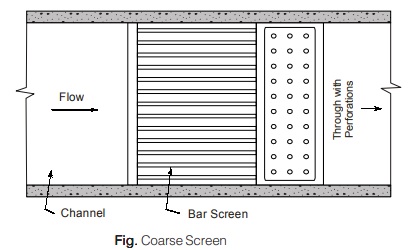Screens
Screens are generally provided in front of the pumps or the intake work, so as to exclude the large sized particles, such as debris, animals, trees, branch, bushes etc. The screens are classified as
(i) Coarse Screen: Coarse screens (generally called trash rack) are sometimes placed in front of the fine screens
- Coarse screens are in the form of bars of 25 mm dia size and or spaced at 75 to 100 mm c/c.
- The screen is placed at a slight inclination at 45° to 60° or 3-6 V : 1 H with horizontal to facilitate raking, reducing the flow velocity. Smaller velocity also helps in racking.

(ii) Fine Screen: Fine screens are normally fitted immediately after the coarse screens. In case of raw storage is provided, the fine screens are provided at the outlet of the storage reservoir.
- Fine screens are in the form of wire mesh with opening less than 10 mm size.
- Since fine screens get clogged frequently hence, head loss increases. Therefore, we try to avoid fine screens. Fine particles may be settled in the sedimentation tank.
- The screening is usually undertaken by continuous belt or drum units fitted with a mesh of 4-10 mm.
Pre-Chlorination
It refers to the practice of injecting chlorine into the raw water when it is not so turbid but has a high bacteria count.
- Fairly high dose of chlorine (2-5 mg/l) is used.
- During the lengthy period spent by water in settling basins, this oxidizes and precipitates iron and manganese.
- It also kills algae and bacteria, reduces colour and slime formation and assists in sedimentation.
- If excessive silt is present in suspension, then prechlorination is not so effective, because silt absorbs chlorine without settling. Hence, in case of heavily turbid water, it is not very effective.
- In case of clear water with high ammonia content, it is effective.
- A drawback of using pre-chlorination is that raw water has a high chlorine demand and more quantity of chlorine is absorbed than in post chlorination. It is not a substitute for post chlorination. It is advantageous when extremely polluted clear raw water has to be used.
The presence of nitrogen in water may be found to occur in one or more of the following forms.
(a) Free ammonia or ammonia nitrogen.
(b) Albuminiod or organic nitrogen.
(c) Nitrites
(d) Nitrates
The free ammonia or ammonia nitrogen indicates very first stage of decomposition of organic matter and consequent release of free ammonia (thus indicating recent pollution), albuminoid or organic nitrogen indicates quantity of nitrogen present in water in form of undecomposed organic matter (mainly in form of proteins and amino acids) which on digestion will release ammonia, the nitrites indicate presence of partly decomposed organic matter and nitrates indicate the presence of fully oxidised organic matter in water (thus representing old pollution).
- Free ammonia in water should not exceed 0.15 mg/L. It is measured by simply boiling the water and measured the liberated ammonia gas, by distillation process.
- Organic nitrogen in water should not exceed 0.3 mg/L. It is determined by digestion of organic matter and measuring the released ammonia gas. It is done by adding strong alkaline solution of potassium permaganate (kMnO4) to already boiled water sample and again boiling the same, when ammonia gas is liberated, which is measured, so as to indicate amount of organic nitrogen present in water. The sum total of ammonia nitrogen and organic nitrogen is known as kjeldahl nitrogen.
- The partly oxidised organic matter present in water in form of nitrites is highly dangerous and therefore, the permissible amount of nitrites present in water should be nil. Measurement of nitrites is done by colour matching technique in which colour is developed by adding sulphonic acid and nepthamine. Measurement of nitrate is done by colour matching technique is which colour is developed, by adding phenol-di-sulphonic acid and potassium hydroxide.
- Presence of nitrate in water is not harmful. However, if its amount is high, then it may adversely affect the health of infants, causing a disease called “mathemoglobinemia” (blue baby disease) (blue baby disease). Hence, its value should be limited to 45 mg/l.
Diseases Disseminated by Water Supplies i.e. Water Borne Diseases
Water borne disease are those disease which spread primarily through contaminated waters and the important water borne disease are:
- Disease Caused by Bacteria Infections
(i) Typhoid fever and paratyphoid fever (caused by Salmonella typhi Bacteria)
(ii) Cholera (caused by vibrio-cholera bacteria)
(iii) Bacillary dysentery (caused by Shiga bacillus or flaner bacillus or sonne bacillus) - Disease Caused by Viral Infections
(i) Infectious hepatitis or infectious Jaundice (caused by hepatitis virus)
(ii) Poliomyelitis (caused by polio virus) - Disease Caused by Protozoal Infections
(i) Amoebic dysentery (caused by entamoeba hystalica germ)
(ii) Giardiasis (caused by Giardia Lamblia) - Diseases Caused by Helminths (Parasitic Worms)
(i) Echinococcosis (hydatidosis, granulosuy dog tapeworms) – (caused by Echinococcus)
(ii) Schistosomiasis or Billhorris (caused by Schistosoma)
<< Previous | Next >>
Must Read: What is Environmental Engineering?

